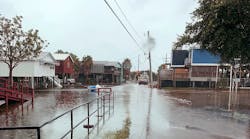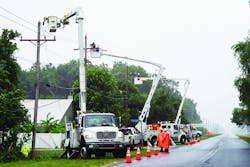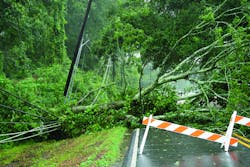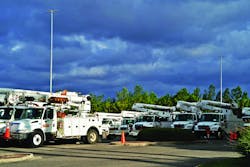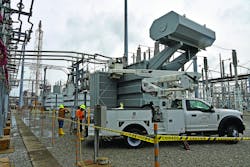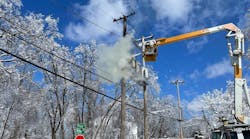In the days leading up to Hurricane Barry in July, Entergy Louisiana prepared for severe thunderstorms, strong winds, heavy rains, higher tides, and coastal flooding. With the path of the storm uncertain at that point, the utility advised its customers to prepare for potential power outages and to visit the Entergy Storm Center.
By July 11, with more information about the potential impact of the storm, Entergy fully engaged its Louisiana command center in anticipation of landfall on July 13. The storm, which made landfall as a Category 1 hurricane before being downgraded to a tropical storm, caused 333,00 customer outages and damaged 426 poles, 170 transformers, 233 crossarms, and 765 spans of wire.
Complicating the restoration, tornadoes passed through Baton Rouge, Louisiana, at the height of the storm, causing additional power outages.
Overcoming Obstacles
Based on the path of the storm, Entergy Louisiana strategically mobilized workers and contractors in locations where they were able to quickly respond once the storm passed and it was safe to start restoration work. These crews included line workers, safety employees, scouts and vegetation workers.
As Barry moved through Louisiana, the crews faced several challenges. When the storm made landfall, the heavy rains and tidal surge caused flooding, making some roads impassable, particularly in southeast Louisiana.
In addition, after Barry passed through south Louisiana, bands of severe thunderstorms with wind speeds exceeding 30 miles per hour swept through the area, making it unsafe for the crew members to use bucket trucks to make repairs. Until the wind subsided, crews concentrated on damage assessments and making repairs that could be done from the ground.
In some areas of Louisiana, crews were faced with closed flood gates. However, working closely with local officials, power restoration crews were able to access those areas as soon as it was deemed safe. In Terrebonne and Lafourche parishes, Entergy Louisiana’s crews encountered equipment that needed to be repaired in areas that were only accessible by boat.
As the storm moved through Baton Rouge, significant downed trees, branches and power lines posed the greatest challenges. Often, the most dangerous part of the storm is after it passes. Downed power lines may still be energized and if there is flooding, debris may cause access issues.
The heavy tree canopy in Baton Rouge required Entergy Louisiana to use the services of additional vegetation management crew members to remove trees before crews could make repairs to the electrical system.
Working in Tight Spots
The highest concentration of damage in Baton Rouge was in residential backyards or alleyways. Rear yard work poses several challenges for restoration.
In areas inaccessible by bucket trucks, Entergy Louisiana brought in backyard machines to help crews access tight spots to restore power.
Because these machines do not have the same lifting and handling capacity as traditional bucket trucks, extra time was needed to lift transformers. Additional crew members were brought in to climb poles to make repairs on downed lines.
Focusing on Safe Work Practices
Safety is a core value at Entergy, and employees work only when and where conditions are safe and secure to do so. For example, during the storm, Entergy’s crews do not work in bucket trucks when there are sustained winds of 30 miles per hour.
While the goal is to restore power as quickly as possible, safety is always the company’s top priority. That includes mandatory safety briefings each morning to ensure crews are familiar with the work focus for the day, proper planning for the weather, safety briefings for all mutual assistance crew and following Entergy’s work/rest rules.
By mobilizing crews in locations near where the storm was predicted to impact, it reduced post-storm travel distances. In addition, mutual aid crews were on standby to come to help once the storm had passed and the teams were able to assess damages.
Requesting Mutual Aid
At Entergy, storm preparation is a continuous cycle. Using a strategic set of action steps, the utility can respond and restore its customers’ power more quickly and more efficiently after every storm.
While each storm is different, the company’s approach is the same. Entergy continually monitors the weather, mobilizes its crews on the ground to respond to power outages quickly and safely and collaborates with local government officials, contractors and neighboring utilities to continuously develop best practices for storm response.
During widespread outage emergencies, Entergy partners with other utilities in mutual assistance agreements to lend a hand. Mutual assistance teams meet annually to strengthen its partnerships.
For Barry, in addition to neighboring Entergy operating companies, employees and contractors were sent from CenterPoint Energy, Florida Power & Light, Gulf Power, Alabama Power and Oncor. When bringing these mutual assistance crews on board, Entergy Louisiana follows a very detailed, rehearsed plan that has worked well during many storm recoveries.
Through advanced planning and preparation, as well as mutual assistance, restoration following Barry was both swift and safe.
Sidebar: Storm Hardening Strategies for Transmission and Distribution
To protect its system against severe weather events like Hurricane Barry, Entergy has hardened its system. Since 2010, Entergy has constructed 16 new transmission lines, rebuilt 21 existing transmission lines and completed 13 reconfiguration projects to make its transmission grid more resilient. The utility has also upgraded nearly 25 critical substations in Louisiana for storm hardening.
In addition, the utility has done the following for its transmission system:
- Employed new engineering design standards that exceed National Electrical Safety Code standards.
- Invested in concrete and steel structures exclusively for transmission projects system-wide, both for replacement and new construction.
- Modernized transmission protection devices to isolate damaged facilities more efficiently.
- Used extreme wind-load criteria of 150 mph on all new standard substation structures installed in the Entergy service territories and extreme wind-load criteria of 140 mph on new or rebuilt lines in the vital transportation, industrial and urban corridor south of Interstate 10.
- Supported all transmission line crossings over Louisiana’s interstates and major highway evacuation routes with steel or concrete structures.
From a distribution perspective, Entergy Louisiana has focused on:
- Deploying storm guys on critical distribution structures in open marsh areas along the coast. Storm guys are tensioned cables designed to add stability to structures.
- Using only class three (or larger) poles for trunk feeder construction on distribution circuits close to the Gulf Coast. Class three poles are rated to withstand 3,000 lbs. of horizontal load.
